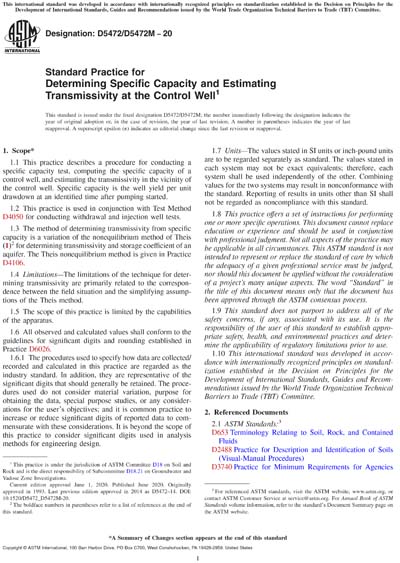Most recent
ASTM D5472/D5472M-20
Standard Practice for Determining Specific Capacity and Estimating Transmissivity at the Control Well
1.1 This practice describes a procedure for conducting a specific capacity test, computing the specific capacity of a control well, and estimating the transmissivity in the vicinity of the control well. Specific capacity is the well yield per unit drawdown at an identified time after pumping started.
1.2 This practice is used in conjunction with Test Method D4050 for conducting withdrawal and injection well tests.
1.3 The method of determining transmissivity from specific capacity is a variation of the nonequilibrium method of Theis (1)2 for determining transmissivity and storage coefficient of an aquifer. The Theis nonequilibrium method is given in Practice D4106.
1.4 Limitations—The limitations of the technique for determining transmissivity are primarily related to the correspondence between the field situation and the simplifying assumptions of the Theis method.
1.5 The scope of this practice is limited by the capabilities of the apparatus.
1.6 All observed and calculated values shall conform to the guidelines for significant digits and rounding established in Practice D6026.
1.6.1 The procedures used to specify how data are collected/recorded and calculated in this practice are regarded as the industry standard. In addition, they are representative of the significant digits that should generally be retained. The procedures used do not consider material variation, purpose for obtaining the data, special purpose studies, or any considerations for the user’s objectives; and it is common practice to increase or reduce significant digits of reported data to commensurate with these considerations. It is beyond the scope of this practice to consider significant digits used in analysis methods for engineering design.
1.7 Units—The values stated in SI units or inch-pound units are to be regarded separately as standard. The values stated in each system may not be exact equivalents; therefore, each system shall be used independently of the other. Combining values for the two systems may result in nonconformance with the standard. Reporting of results in units other than SI shall not be regarded as noncompliance with this standard.
1.8 This practice offers a set of instructions for performing one or more specific operations. This document cannot replace education or experience and should be used in conjunction with professional judgment. Not all aspects of the practice may be applicable in all circumstances. This ASTM standard is not intended to represent or replace the standard of care by which the adequacy of a given professional service must be judged, nor should this document be applied without the consideration of a project’s many unique aspects. The word “Standard” in the title of this document means only that the document has been approved through the ASTM consensus process.
1.9 This standard does not purport to address all of the safety concerns, if any, associated with its use. It is the responsibility of the user of this standard to establish appropriate safety, health, and environmental practices and determine the applicability of regulatory limitations prior to use.
1.10 This international standard was developed in accordance with internationally recognized principles on standardization established in the Decision on Principles for the Development of International Standards, Guides and Recommendations issued by the World Trade Organization Technical Barriers to Trade (TBT) Committee.
Content Provider
ASTM International [astm]






